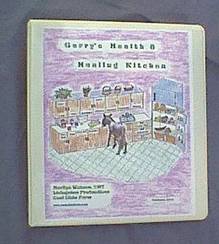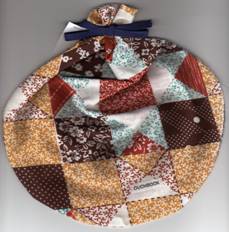
"Gerry's Health & Healing Kitchen"
Order: #GHK $35.00 + $6.00 shipping*-currently unavailable
*See Customer ASSistance section for more shipping options.
___________________________________________________________________________________________________________________

This Rice Bag provides deep penetrating relief with a moist heat, without the water! The fabric in this bag allows the rice to perform at peak capacity. The properties of the rice calm & relax the entire body. Re-use over & over to deliver unparalled relief from painful injuries, muscle damage, surgical sites. It also draws out toxic tissue waste & reduces swelling. Light weight & very gentle on painful areas, this bag is truly a "warm fuzzy".
The performance of this bag is far superior to putting a large bag of rice in a sock &/or using the large, heavy heat packs sold elsewhere.
Complete instructions are included with the Rice Bag. Size: 8" in diameter is perfect for most any area. You & your animals will want your own personal bag!
Order: #RB $3.75 each
** Flat Rate Shipping for any quantity: $3.00**
___________________________________________________________________________________________________________________
West Nile
Prevention, Treatment, Recovery
Available to you, is a clinical report that tells you the TRUTH about the symptoms; what changes to look for; & two proven herbal treatments, one for prevention & one for treatment of West Nile
There are no dangerous side effects or threat of death as is the case with the vaccines. Animals naturally accept the herbs in their food, so you are not fighting with them to take it. The same formula is also effective in humans.
I had West Nile myself. I was the first human case in this area & they denied what they saw, were afraid of me, & wanted me to disappear. I came within an inch of dying & I did not fit CDC's description that" only old, diseased, &/or sickly people get &/or die from West Nile." In fact, I was quite the opposite.
In the clinical report, all of the information is provided as to how we knew we were infected, how we felt, what we did day-by-day; information on purchasing the herbs; how to administer as a preventative & as a treatment.
West Nile IS nasty stuff. The symptoms are NOT flu-like & it does NOT go away in a few days. It took me seven weeks to get over it.
This report contains information on MANY other confirmed cases with which I was a part in the treatment & recovery. Email us to request a copy of the report. There is a minimal shipping fee.
Reply to: DanteBaron@earthlink.net
___________________________________________________________________________________________________________________
Onicomycosis / White Line Disease
In the late 1980's & through the 1990's we noticed a rise in this problem. Otherwise healthy horses were becoming infected. Onicomycosis involves a fungal invasion within the layers of the hoof wall, NOT the white line itself. It is close to the white line, but does not involve it. Application of antifungals slows the process, but does not heal the hoof. This has to be treated orally. The occurrence of this problem is brought about by a thyroid imbalance. Accurate thyroid diagnosis is done through the recording of the animal's base line temperature. The blood test for thyroid function is only accurate when a severe condition exists.
Vitamin/hoof supplements sold on the market are little if any help.
Until the thyroid is addressed & the horse's system is detoxified,
the problem will remain. This is covered at length in our book
"Gerry's Health & Healing Kitchen".
White line disease is a lesser problem compared to onicomycosis. Many think these are one in the same. A different type of fungus invades the white line & causes the powder like crumbling in the area. This fungus causes separation of the wall from the sole & whlte line. As much as one quarter inch depth in the crumbling away of the sole/white line tissue does not harm the horse in the way of pain. However, it needs to be addressed. The antifungals &/or 7% iodine solution are very effective in treating the fungus. Treatment, follow-up, & prevention are also covered in "Gerry's Health & Healing Kitchen" book.
___________________________________________________________________________________________________________________
The nightmare of all horse, donkey, & mule owners is not quite the terror it used to be. It is a serious problem, but it can be treated & dealt with in a much shorter time frame with complete recovery!
A horse with as much as 19 degree rotation can completely recover. An amazingly simple discovery was made when a mare I have contracted EPM & aborted a foal. She consequently was treated with massive doses of tribrissen paste. The antibiotic caused a massive intestinal disruption of which we are all aware of, thus, she foundered as we expected. The rotation was severe in both front feet. I put bar shoes on her for 30 days. At that time, she was stable & I was able to remove the shoes. Subsequent horses have been treated without the bar shoes & have fully recovered in 30 days.
All of these animals are being ridden & are living full, healthy lives.
This treatment procedure is fully explained & illustrated in "Gerry's Health & Healing Kitchen" book.
___________________________________________________________________________________________________________________
Colic: Overlooked Common Mistakes
Feed is a common culprit. When purchasing feed, note the date on the bag. If the date is over 14 days, with most feed, you don't want to buy it. The manufacturer's like to tell you fantasy stories about the feed holding up for six months. Protruded feeds such as Purina's Althlete have a longer shelf life of 3 months, however, pellets, grain, etc. don't. If the feed isn't consumed within six weeks of its' manufactured date, the quality becomes questionable.
Feed can go bad without necessarily smelling bad. It will also change in consistency, ie, powder, crumble without smelling. If you do not clean out your storage container & you leave just ONE little grain/piece, that one particle can mold in the bottom & thus, spread through the new feed.
Hay is a tricky subject as well. It takes knowledge in knowing what to look for, a keen sense of smell, & knowing the difference between dust & mold when the "cloud" rises as you serve the hay.
Hay storage is where many people error. It is not given the careful thought & attention as it should. Hay needs to VENT, needs air FLOW, & a shaded DRY storage area. Covering it with the plastic tarps to keep it dry- from rain is a great way to grow mold. If you must cover it with one of these tarps, sit something on the hay or tie the tarp above the hay so that there is air space between the two.
Storing hay on concrete or brick flooring is another opportunity for spoilage of considerable proportion. Like your feed store uses pallets to keep the bags off of the concrete floor, the same needs to apply for the hay.
More detail & photos about this subject can be found in "Gerry's Health & Healing Kitchen" book.
___________________________________________________________________________________________________________________
Your equine friend can enjoy much of what you have in YOUR refrigerator. Not
only are the fruits & veggies on their natural eating list, they are GOOD
nutrition for them.
Oranges, bananas, melons, strawberries, grapes, pears, peaches (without the seed!) are just a few items they can have. Then there are all of the apples, carrots, & yes, corn. When you have corn on the cob, instead of throwing away the cob, break it into (1/2) & let your horse enjoy it. Half of one ear is enough for a snack or treat. Put the rest in a zip bag & store in your refrigerator & it will be there for the next day.
After your horse gets hot or has a work-out offer them Gatorade. It is cheaper than buying the electrolyte pastes & water additives. They love Gatorade & it serves as a nice treat for them. Their favorite flavors are usually melon, citrus, grape, & fruit punch. Putting it in your blender with some ice cubes & making a "smoothie" is particularly appreciated by them. You can judge the amount they need by the enthusiasm they show for drinking it. If they have enough, they will drink it slowly or stop drinking it, just as we do. The suggested amounts, etc. for the smoothies & other goodies can be found in "Gerry's Health & Healing Kitchen" book. Instead of throwing away things from your kitchen, with a little care, you can provide your horse with special treats without spending a lot of money on prepared/packaged treats.
___________________________________________________________________________________________________________________
Vaccination Schedules & Administration
Though provided, the 5-way vaccines are not a good idea. You are injecting too many antigens for your animal to deal with effectively, for immunity. Any 3-way vaccine is more than enough-whether it is a horse, donkey, or any of the minis. There should be 3 weeks between vaccines; ie , given rabies & encephalitis combos with tetanus.
Three weeks gives the animal time to produce protection & recover before being hit with another immune challenge, be it another vaccination or a show/trail ride trip.
All minis should receive half of the normal dose for horses. It is just too much to give the little bodies. Standard donkeys can tolerate the full dosage; however, the sensitive individuals can do well to receive 75% of the full dose.
Vaccines should be administered in early spring when the weather has moderated a bit, but before the insects become active. You want to avoid drastic changes in the weather which stresses the animals. If you vaccinate two weeks prior to a show you risk stressing the animal. They could become ill at the show, once home, or typically 7-10 days later. The factor of when you also schedule de-worming determines the level of immunity. De-worming should be done SEPARATELY from vaccination. Give your equine at least a week to "process" the chemical & parasitical treatment before stressing the system with a vaccination or show/trail ride trip in the trailer. De-worming healthy animals doesn't tax the system like the vaccinations do, but it is wise to provide a one-week window" for recovery.
Don't forget, they are just like us- when we stay at home & don't mix/socialize we tend to stay healthy. When we leave home & mingle with the masses, we pick up germs & often "come down" with something.
___________________________________________________________________________________________________________________
___________________________________________________________________________________________________________________

Livingston Productions @ Casi Cielo Farm | 10 West Buckhorn Trl. | Greenville Florida 32331
Email: Dantebaron@casicielofarm.com | Phone: 850-342-1193 or 850-363-1992 between 8AM and 10 PM Eastern
Our remote farm has intermittent internet & phone service. If you don't get a response from us, please try again & possibly both phone numbers. We ARE here & are open for business since 2004.Web Design and Content by: Marilyn Watson
All material contained in this website is subject to copyright © Livingston Productions @ Casi Cielo Farm
